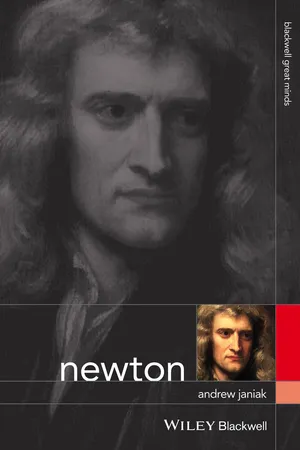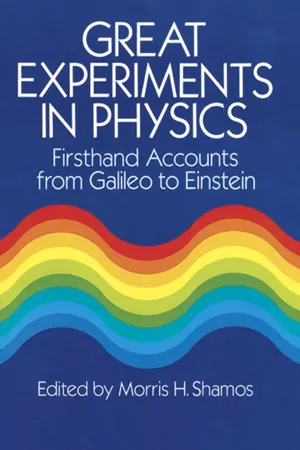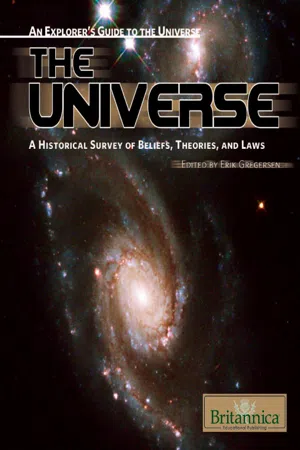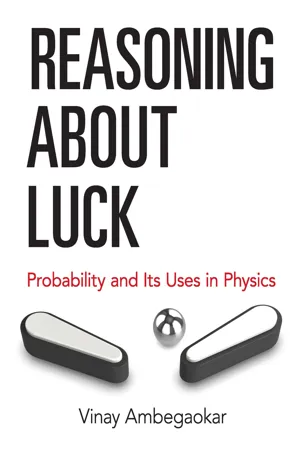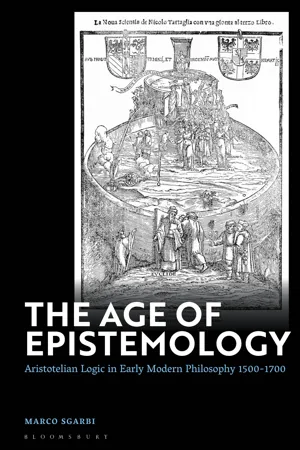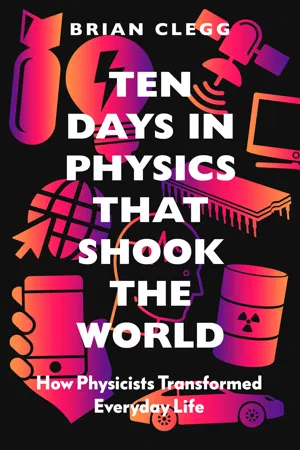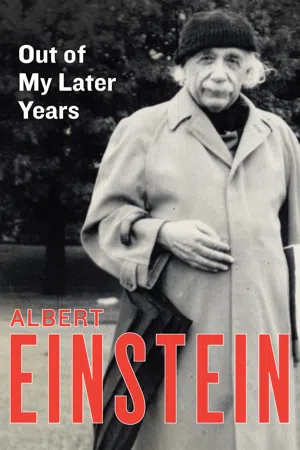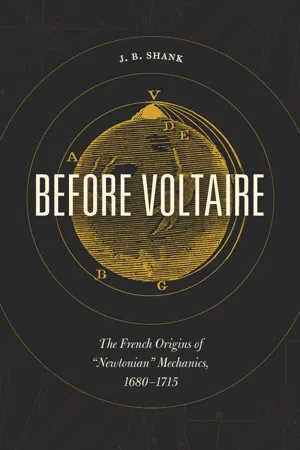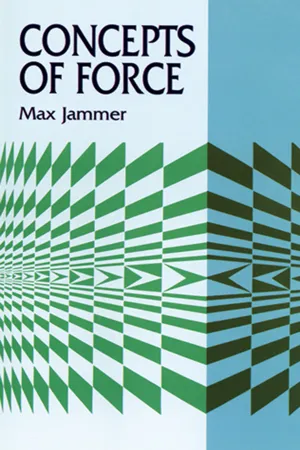Physics
Isaac Newton
Isaac Newton was a renowned physicist who made significant contributions to the field of physics. He is best known for his laws of motion and universal gravitation, which laid the foundation for classical mechanics. Newton's work revolutionized our understanding of the physical world and remains fundamental to the study of physics today.
Written by Perlego with AI-assistance
Related key terms
Related key terms
1 of 4
Related key terms
1 of 3
10 Key excerpts on "Isaac Newton"
- eBook - ePub
- Andrew Janiak(Author)
- 2015(Publication Date)
- Wiley-Blackwell(Publisher)
chapter 2 was newton a scientist?What was Isaac Newton? A mathematician: along with his eventual rival, the German figure G.W. Leibniz, he codiscovered calculus and made many other lasting contributions to the development of modern mathematics. A scientist: he discovered not only the three laws of motion that became the underpinning of physics in the modern era but also the law of universal gravitation, which pointed the way toward a unified treatment of terrestrial and celestial phenomena within a single physical theory of nature. As if that were not enough, he also made fundamental contributions to experimental optics in the late seventeenth century in the Philosophical Transactions of the Royal Society and in the early eighteenth century in his Opticks. Indeed, Newton is remarkable for the fact that his work as a theoretician is matched by his work as an experimentalist—either aspect of his oeuvre would be sufficient to secure his place in the canon of modern science. So in the popular imagination and in the history books, Newton is seen as one of the greatest scientists of the past three centuries, on a par with few others, perhaps just Darwin and Einstein. This is surely the view that will dominate our understanding of Newton in the twenty-first century and well beyond. And for many purposes, this view ought to remain the standard. This is what Newton means to us.But what if our question is not, what does Newton mean to us? What if our question is, how was Newton understood during his own lifetime? Alternatively, how did Newton understand what he was doing? These are the kinds of question that animate historical research in general and scholarship in the history of philosophy in particular. It is not as if the popular view of Newton is false; he did in fact accomplish everything attributed to him, if not considerably more (taking various unpublished manuscripts and correspondence into account). The problem is that the view is not precise: there are important historical reasons for concluding that although we may wish to view Newton as a scientist, it would be more accurate to think of him in another, slightly different, way.1 The simplest of these historical reasons is that no such category existed during Newton’s day. The category of the scientist—along with that word in English—is actually a nineteenth-century invention. Unlike many inventions, whose exact origins remain murky, we can say precisely when this category arose: at a meeting of the British Association for the Advancement of Science in June 1833, the Cambridge philosopher William Whewell coined the word scientist to capture a new category of intellectual. At the meeting, Whewell said that just as the practitioners of art are called artists, the practitioners of science ought to be called scientists, indicating that they should no longer be called philosophers. Whewell was responding to Samuel Taylor Coleridge’s plea that the members of the British Association stop calling themselves natural philosophers, for the scope of their research had narrowed considerably in recent years (Cannon 1978, 201–202, Schaffer 1986, Snyder 2011, 1–7).2 The first time that scientist was used in print was a year later, when Whewell discussed the outcome of the British Association meeting in his (anonymous) review of Mary Somerville’s book, On the Connexion of the Physical Sciences - eBook - ePub
Great Experiments in Physics
Firsthand Accounts from Galileo to Einstein
- Morris H. Shamos(Author)
- 2012(Publication Date)
- Dover Publications(Publisher)
4The Laws of Motion
Isaac Newton 1642 -1727 1642-1727THE ESSENTIAL STRENGTH of the science of physics lies in the great depth of its conceptual schemes, in the relatively few principles that serve to unify the entire range of man’s knowledge of the physical universe. The first and most remarkable synthesizer in the history of science was Isaac Newton, who discovered the law of universal gravitation, completed the formal development of the mechanical principles outlined by Galileo, made important contributions in other branches of physics, and inspired, in part, the Enlightenment which climaxed the intellectual revolution in philosophy toward the end of the seventeenth century. His was a modern approach to science in every major respect, yet he practiced alchemy. By this paradox one can visualize how little scientific understanding prevailed even in Newton’s time. Physics was still a tottering infant in the last half of the seventeenth century.Newton was born at Woolsthorpe, in Lincolnshire, England, on December 25, 1642, the year of Galileo’s death. His childhood was uneventful, aside from the fact that it was shadowed by the civil war brought on by the excesses of Charles I. He attended village schools until he was twelve, when he was sent to the King’s School at Grantham, several miles from his home. Here, though not a precocious youngster, he eventually reached top rank by applying himself diligently, perhaps, as the story goes, because of his desire to best another young man in his class. After attending school for four years he was withdrawn by his mother, recently widowed for the second time, to help with the management of their farm. He was singularly unsuccessful in this enterprise, having no interest whatever in farming; thus, after a short time, he returned to school to prepare for admission to the university.Newton entered Trinity College, Cambridge, in 1661, the year after the Restoration of Charles II. Probably the effects of the Restoration were still noticeable at the university, judging from reports that the students, because of the unsettled atmosphere, were more than ever boisterous and rowdy. Being very much an introvert, and not given to frequent merrymaking, Newton tended to withdraw from his fellow students and to devote himself to scholarly pursuits. He did not distinguish himself in his early years at college until he came under the tutorship of Isaac Barrow (1630–1677), a distinguished mathematician and Greek scholar, who had transferred from a professorship of Greek to the Lucasian chair of mathematics in 1663. From that point on it seemed that Newton had found himself, for his extraordinary talents soon became evident. Several months after receiving his B.A. degree in 1665 the university was closed because of the prevalence of bubonic plague. Newton returned to his home in Woolsthorpe and spent this period of enforced “idleness” in contemplation of nature’s ways. During the next two years, most of which were spent at home, he made his greatest discoveries. - eBook - ePub
The Universe
A Historical Survey of Beliefs, Theories, and Laws
- Britannica Educational Publishing, Erik Gregersen(Authors)
- 2009(Publication Date)
- Britannica Educational Publishing(Publisher)
EWTON’S IMPACT AND 19TH- CENTURY ADVANCEMENTST wo towering achievements paved the way for Sir Isaac Newton’s conquest of the dynamical problem of planetary motions: his discoveries of the second law of mechanics and of the law of gravitation. The second law of mechanics (that the change of velocity of a body times its mass is proportional to the force impressed) asserted how any body moves when it is subjected to external forces. The law of gravitation asserted that two massive bodies attract one another with a force directly proportional to the product of their masses and inversely proportional to the square of their distance. By pure mathematical deduction, Newton showed that when these two general laws were applied to the celestial realm, the result was Kepler’s three laws of planetary motion. This brilliant coup completed the Copernican program to replace the old worldview with an alternative that was far superior, both in conceptual principle and in practical application. In the same stroke of genius, Newton unified the mechanics of heaven and Earth and initiated the era of modern science.NEWTON’S LAW OF GRAVITATION
Newton’s law of gravitation states that any particle of matter in the universe attracts any other with a force varying directly as the product of the masses and inversely as the square of the distance between them. In symbols, the magnitude of the attractive force F is equal to G (the gravitational constant, a number the size of which depends on the system of units used and which is a universal constant) multiplied by the product of the masses (m 1 and m 2 ) and divided by the square of the distance R: F = G (m 1 m 2 )/R 2 - eBook - ePub
- Vinay Ambegaokar(Author)
- 2017(Publication Date)
- Dover Publications(Publisher)
6
Forces, motion, and energy
... the whole burden of philosophy seems to consist in this – from the phenomena of motions to investigate the forces of nature, and then from these forces to demonstrate the other phenomena ... Isaac NewtonProbability enters theoretical physics in two important ways: in the theory of heat, which is a manifestation of the irregular motions of the microscopic constituents of matter; and, in quantum mechanics, where it plays the bizarre but, as far as we know, fundamental role already briefly mentioned in the discussion of radioactive decay.Before we can understand heat, we have to understand motion. What makes objects move, and how do they move? Isaac Newton, in the course of explaining the motion of planets and of things around us that we can see and feel with our unaided senses, answered these questions for such motions three centuries ago. The science he founded has come to be called classical or Newtonian mechanics, to distinguish it from quantum mechanics, the theory of motion in the atomic and sub-atomic world.Classical mechanics is summarized in Newton’s laws’ of motion. These will here be illustrated by an example involving the gravitational attraction, described by Newton’s ‘law’ of gravitation. In the brief description that follows, I shall attempt to show that these laws of nature: (i) unify apparently unrelated phenomena – like the motion of the moon and the fall of an apple; (ii) make simple but astonishing quantitative connections – between, for example, the rate of the moon’s revolution around the earth and the numerical value of the acceleration in an apple’s fall; and (iii), suggest new and useful concepts – here kinetic energy, potential energy, and, more generally, energy – which provide access to unexplored territory.To say that an object moves is to say that its position in space changes with time. This can only be given meaning by referring it to some fixed point. Imagine a straight line directed from such a fixed point to the place where our object is. This directed line is called the position ‘vector’ of the object. The word vector is used to indicate something that has a magnitude and a direction. We shall encounter other vector quantities soon. Two vectors are said to be equal when they have the same magnitude and - eBook - ePub
Revival: A History of Modern Culture: Volume II (1934)
The Enlightenment 1687 - 1776
- Preserved Smith(Author)
- 2018(Publication Date)
- Routledge(Publisher)
Chapter IINewtonian Science1. Astronomy from the Death of Galileo to the Publication of Newton’s “Principia”
In the year that Galileo died (1642) there was born another astronomer and physicist destined to win even greater renown. The fame of Sir Isaac Newton is, indeed, as supreme and all but matchless in the realm of science as is that of Shakespeare in poetry and that of Napoleon in arms. The posthumous son of a small yeoman, he was born at Woolsthorpe, Lincolnshire, and grounded in the elements of religion and letters by his stepfather, a clergyman. Attending the King’s School at Grantham, he mastered Latin so well as to become head boy, and to induce his family to send him to Cambridge University. While his four years at Trinity College (1661-65) gave him a mastery of mathematics and of polite learning and a considerable interest in ancient history and in theology, his real education—as is almost always the case with genius—was won by himself in extra-curricular studies. An acquaintance with an apothecary gave him an introduction to chemistry, and the reading of Kepler’s Optics opened his mind to the wonders of physics. The acquisition of this book was the crucial date in his development. From the German scientist, whose influence over him can hardly be exaggerated, he obtained the starting-point for his investigations in all the three fields—astronomy, physics, and mathematics—to which he contributed so much.With the characteristic precocity of genius he made his most important discoveries before he had reached the age of twenty-four. The law of gravitation, the principles of the calculus, and the theory of light, all germinated in his mind as early as the year 1666. Except his precocity, however, nothing is more remarkable than his slowness in publication. Unwilling to put forth anything premature or incomplete, he spent years of arduous toil in testing and perfecting his ideas before he submitted them to the judgment of the public. - eBook - ePub
The Age of Epistemology
Aristotelian Logic in Early Modern Philosophy 1500-1700
- Marco Sgarbi(Author)
- 2023(Publication Date)
- Bloomsbury Academic(Publisher)
11 Isaac NewtonLondon. 1688. The Mathematical Principles of Natural Philosophy had been published the previous year in 1687.1 Its author was one of the most eminent members of The Royal Society of London and was soon to become the most influential figure in England, if not the single most important philosopher and scientist in the eighteenth century. The individual in question was Isaac Newton. His masterpiece was an immediate success, thanks to the propaganda exercised by the Royal Society’s fellows all over Europe. It has been called the ‘Newtonian moment’. His success was paralleled only to the obscurity of the text.2The Principles was received in four different reviews: the Philosophical Transactions , the Bibliothèque Universelle , the Journal des Sçavans and the Acta Eruditorum .3 The reviewers were, respectively, Edmund Halley, John Locke, Pierre-Sylvain Régis and Christoph Pfautz, though in the latter three cases the reviews appeared anonymously. All of these reviewers were eminent scholars, who but nonetheless with different philosophical and scientific interests and backgrounds. Their reviews were generally positive. Halley was not an impartial judge: he saw and revised the drafts of Newton’s work before publication. Pfautz made the most competent critical assessment, while Locke was Newton’s friend and probably he had some difficulty understanding the mathematical apparatus developed in the text.Régis’s review, by contrast, was more troublesome for Newton not because it dismantled some of his conclusions, but because it made him reflect on his global philosophical enterprise. Indeed, Régis was mainly concerned with philosophical issues and did not apply himself to explaining Newton’s mechanics. His main critique was that Newton’s demonstrations were merely mathematical: they provided a wonderful description of the world in numbers, but did not give a physical account of how that world was in reality. Newton’s mechanics, according to Régis, had no bearing on metaphysics or on natural philosophy because it did not explain the true nature of ‘force’, ‘gravity’, ‘matter’ or other similar concepts. Régis emphasized how Newton’s argument proceeded ‘only by hypotheses which are, for the most part, arbitrary, and which therefore can serve as foundation only for a treatise in the realm of pure mechanics’.4 In other words, Régis was describing Newton’s lifetime achievement as Andreas Osiander had done for Copernicus De revolutionibus orbium coelestium - eBook - ePub
Ten Days in Physics that Shook the World
How Physicists Transformed Everyday Life
- Brian Clegg(Author)
- 2021(Publication Date)
- Icon Books(Publisher)
‘hypotheses non fingo’ in the original Latin). The requirement of his theory for bodies to influence each other at a distance was described at the time as occult, meaning hidden, because there was no obvious mechanism by which it could work. It would not be until Einstein’s development of the general theory of relativity more than 300 years later that Newton’s work would be refined to more accurately reflect reality and an explanation would be provided for gravity’s action at a distance.Underlying the Principia is another of Newton’s great pieces of original thinking – calculus. Although the vast majority of the mathematical calculations on show within the book are made geometrically, there is no doubt that calculus, the mathematics of change that is especially suited to the kind of varying acceleration necessary to deal with the mechanics of movement and gravitation, was central to the development of his theory. Newton does include its use, but far less than he could have done. However, calculus has to take something of a back seat in our exploration of this particular day, both because it was developed in parallel by Gottfried Leibniz (devising the terminology and notation we still use today), and because its use is mostly hidden in the Principia.Newton, the person
Newton is regularly placed on a pedestal with a handful of others as a transformative genius, yet science is a collaborative process in which no one operates in isolation. Newton himself appeared to highlight this in his famous quote ‘If I have seen further it is by standing on ye shoulders of giants’, though this is now generally thought to have been a put-down. It appears in a letter to Robert Hooke, who, as we 19 - eBook - ePub
Out of My Later Years
The Scientist, Philosopher, and Man Portrayed Through His Own Words
- Albert Einstein(Author)
- 2011(Publication Date)
- Philosophical Library/Open Road(Publisher)
Such experience, however, was available to Newton. The acceleration of the moon was known from its orbit and could be compared with the acceleration of the freely falling body on the surface of the earth. Furthermore, the movements of the planets about the sun had been determined by Kepler with great exactness and comprehended in simple empirical laws. So it was possible to ascertain how the effects of gravitation coming from the earth and those coming from the sun depended on the factor of distance. Newton found that everything was explainable by a force which was inversely proportional to the square of the distance. And with that the goal was reached, the science of celestial mechanics was born, confirmed a thousand times over by Newton himself and those who came after him. But how about the rest of physics? Gravitation and the law of motion could not explain everything. What determined the equilibrium of the parts of a solid body? How was light to be explained, how electrical phenomena? By introducing material points and forces of various kinds acting at a distance, everything seemed in a fair way to be derivable from the law of motion.That hope has not been fulfilled, and no one any longer believes in the solution of all our problems on this basis. Nevertheless, the thinking of physicists today is conditioned to a high degree by Newton’s fundamental conceptions. It has so far not been possible to substitute for the Newtonian unified conception of the universe a similarly unified comprehensive conception. But what we have gained up till now would have been impossible without Newton’s clear system.From observation of the stars have chiefly come the intellectual tools indispensable to the development of modern technique. For the abuse of the latter in our time creative intellects like Newton’s are as little responsible as the stars themselves, contemplating which their thoughts took wing. It is necessary to say this, because in our time esteem for intellectual values for their own sake is no longer so lively as it was in the centuries of the intellectual renascence.Passage contains an image 31 Johannes Kepler
IN KEPLER’S LETTERS we find ourselves confronted with a sensitive personality, passionately devoted to the quest for deeper insight into the character of natural processes—a man who reached the exalted goal he set himself in spite of all internal and external difficulties. Kepler’s life was devoted to the solution of a dual problem. The sun and the planets change their apparent position with reference to their background of fixed stars in a complex manner open to immediate observation. In other words, all the observations and records compiled with such care dealt not actually with the movements of the planets in space but with temporal shifts undergone by the direction earth-planet in the course of time. - eBook - ePub
Before Voltaire
The French Origins of “Newtonian” Mechanics, 1680-1715
- J.B. Shank(Author)
- 2018(Publication Date)
- University of Chicago Press(Publisher)
For the eighteenth century . .. it only remained for mathematicians to arrange the details of the Newtonian universe in somewhat more exact order.” 18 In 1980, I. Bernard Cohen elaborated the same understanding in even greater detail in his book The Newtonian Revolution. Cohen argued that “a revolution in the sciences was wrought by and revealed in the Principia” such that it became “the standard by which all other science was measured.” 19 George Smith, a self-professed follower of Cohen’s Newtonian Revolution approach, echoed the same understanding in 2007 in his entry on Newton’s Principia in the Stanford Encyclopedia of Philosophy. “By the last decades of the [eighteenth] century,” Smith writes, “no one could deny that a science had emerged [from Newton’s Principia ] that, at least in certain respects, so far exceeded anything that had ever gone before that it stood alone as the ultimate exemplar of science generally.” What ensued was a new project: finding “the precise nature and limits of the knowledge attained in this science” and the methods by which “this extraordinary advance had been achieved.” 20 The still widely prevalent view, articulated here by Mach, Hall, Cohen, and Smith, which holds Newton to be the father of modern mathematical physics, and which sees the development of this science after 1700 as the overdetermined consequence of the reception of the Principia, remains stubbornly persistent. This is especially true in the recent historical work on the Principia written by Anglo-American academic philosophers. 21 In the philosophical histories of the Newtonian influence, the Principia is taken without argument to have been a singular step forward in the making of modern science - eBook - ePub
- Max Jammer(Author)
- 2012(Publication Date)
- Dover Publications(Publisher)
304A few lines later Newton stresses the point again: “considering those forces not physically, but mathematically.” These remarks seem to indicate that Newton was already groping after a somewhat more positivistic interpretation of the concept of force.Newton’s ultimately undecided position with respect to the real nature of force in general, and also, as we shall see later on, with respect to gravitational forces in particular, shows the incredible greatness of his genius. Not only did he establish the first self-contained system of physical causality, capable of representing the deeper features of physical experience and, in addition, highly satisfactory from the logical point of view, but he surpassed himself, so to speak, in conceiving the problematic character of the fundamental notions of his system. Einstein, on the occasion of the two hundredth anniversary of Newton’s death, declared: “Newton himself was better aware of the weaknesses inherent in his intellectual edifice than the generations of learned scientists which followed him. This fact has always aroused my deep admiration.” 305Newton’s expression of force as rate of change of momentum seems to suggest that he was led to this formulation by the study of the laws of impact of solid bodies. As a matter of fact, the phenomena of impact and collision were the subject of most intensive study during the decades preceding the publication of the Principia; Galileo had already recognized the importance of experiments on percussion for a clear comprehension of the concept of force and wrote a special treatise on this subject, entitled “On the force of percussion.”306 It is here that Galileo for the first time brings force in relation with momentum (we ignore his confounding of mass and weight): “It is manifest,” he says, “that the force of the mover or the resisting object is not a simple concept, but composed of two ideas which together determine the energy to be measured; one is the weight [mass], the other speed.”307 It has even been suggested that Descartes’s identification of force with momentum might have had its origin in this passage, a conjecture that is unlikely, since the Elzevir edition, which alone could have been accessible to Descartes, did not contain this treatise. We also know that as early as 1639, when Marcus Marci, the rector of the University of Prague, published his De proportione motu 308 dealing with the problem of impact, the interest of the great theoreticians of mechanics was focused on these problems; and, in 1668, encouraged by a request of the Royal Society, Wallis, Wren, and Huygens found the final solution of the problem of impact, Wallis for inelastic bodies, Wren and Huygens for elastic bodies. No doubt, Newton had read their communications to the Royal Society and it may well be that under their influence Newton formulated his second law by means of the concept of momentum, although he undoubtedly recognized the fundamental importance of the Galilean concept of acceleration in this respect. The ultima ratio
Index pages curate the most relevant extracts from our library of academic textbooks. They’ve been created using an in-house natural language model (NLM), each adding context and meaning to key research topics.
Explore more topic indexes
Explore more topic indexes
1 of 6
Explore more topic indexes
1 of 4
